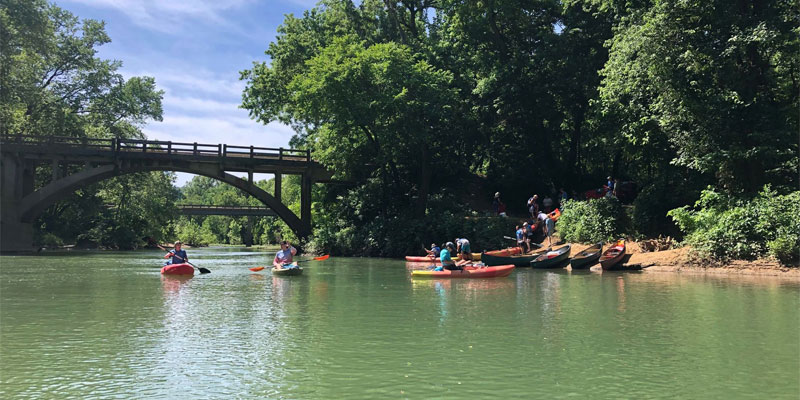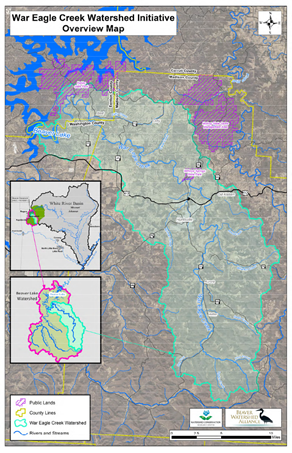
The Source: November 2022
Beaver Watershed Alliance (BWA), in partnership with Beaver Water District (BWD) and the Watershed Conservation Resource Center (WCRC), recently learned that it will receive $5 million in funding for the War Eagle Creek Watershed Initiative. BWA and WCRC applied last spring for funding from the Regional Conservation Partnership Program (RCPP) through the Natural Resources Conservation Service (NRCS). Funding includes $2.4 million from the NRCS and an additional $2.6 million in cash and in-kind match from conservation partners like Beaver Water District. BWD will be contributing $745,000 cash and $1.3 million in-kind to the project over a period of five years.

War Eagle Creek is one of six major tributaries to the White River forming Beaver Lake, the primary drinking water source for Northwest Arkansas (NWA). War Eagle Creek Watershed is the largest of the six major tributaries with land uses that include 52% forest, 37% pasture, and 1300 miles of unpaved roads. The War Eagle Creek Watershed Initiative will protect drinking water for more than 550,000 Arkansans, improve the local farming economy, improve wildlife and aquatic ecosystems, and address major resource concerns, including soil, water, plants, and animals.
These same partners recently completed another RCPP along a portion of the West Fork of the White River. Partly due to the success of that project, we applied again and were selected to receive funding. The West Fork RCPP included large scale stream restoration work, landowner best management practices, and education and outreach. Funding for the War Eagle Creek Watershed Initiative will go toward a variety of projects but will focus on three important areas: sediment catchment, river and riparian restoration, and unpaved roads. Each of these three are important for reducing sediment and nutrient runoff to our drinking water source.
- Catching the sediment will occur by a new take on an old conservation practice. Specially designed ponds installed in headwater areas will capture runoff and slowly drain the water, catching sediment in the process and slowing down water velocity in headwater streams.
- River and riparian restoration work will help stabilize streambanks that are responsible for the majority of sediment that drains to Beaver Lake.
- Since unpaved roads are also a major source of sediment during runoff events, we will implement the tried and tested practices established by the Arkansas Unpaved Roads Program. This will help maintain unpaved roads in peak condition and mitigate sediment loss.
Specific outcomes for the program include at least one large stream restoration be implemented on the War Eagle Creek. Using natural channel design principles, at least a 75% reduction in sediment and phosphorus loadings from accelerated streambank erosion should occur. A total of 100 conservation-based plans will be developed and three non-US government-held conservation easements will be achieved. This initiative will also benefit eight threatened and endangered species identified in the War Eagle watershed. The economic impact will be significant advancements in conservation and capacity of local programs, as well as benefits directly to producers which lower their out-of-pocket costs to implement land management practices. Social outcomes will include the opportunity to provide technical assistance and implement land management practices to hundreds of producers, many of which previously applied for assistance but did not receive financial aid because of a lack of funding. Historically underserved groups will benefit greatly from increased efforts to provide accessibility of program components and education on conservation benefits.
Other partners in the War Eagle Creek Watershed Initiative include:
- Northwest Arkansas Land Trust
- Arkansas Game and Fish Commission
- H2Ozarks
- Farm Bureau
- Arkansas Department of Agriculture
- Madison and Washington Counties Soil and Water Districts
- Arkansas Archaeological Survey
- Hispanic Women’s Organization of Arkansas
For more general information on the program, please reach out to James McCarty at Beaver Water District (jmccarty@bwdh2o.org). If you are a landowner in the War Eagle Creek Watershed and would like to know how to participate, please reach out to the Beaver Watershed Alliance (info@beaverwatershedalliance.org).
